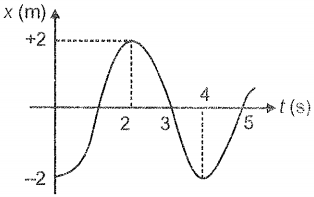Two pendulums A and B of length 144 cm and 100 cm are initially in the same phase at their equilibrium positions. After how much complete oscillations of B, they come in the same phase?
1. 4
2. 6
3. 8
4. 10
| 1. | the gravity of the earth | 2. | the mass of the block |
| 3. | spring constant | 4. | both (2) & (3) |
A particle is moving along X-axis (x in meter) and force acting on particle varies as F = -5x + 5N, then
1. The motion of particle will be circular
2. The motion of particle will be periodic having a mean position at x = 1m
3. The equilibrium position of the particle will be at x = 4m
4. Both (1) & (2)
Given below are two statements:
| Assertion (A): | The periodic time of a hard spring is more as compared to the soft spring. |
| Reason (R): | The spring constant of hard spring is less. |
Choose the correct option from the given ones:
| 1. | Both (A) and (R) are True and (R) is the correct explanation of (A). |
| 2. | Both (A) and (R) are True but (R) is not the correct explanation of (A). |
| 3. | (A) is True but (R) is False. |
| 4. | (A) is False but (R) is True. |
A particle is executing SHM along a straight-line path. Then which of the following statement is correct?
1. Acceleration always decreases the speed of the particle
2. Acceleration is constant with time
3. Acceleration is constant with position
4. Acceleration is maximum when the particle is at rest
A body executes oscillations under the effect of a small damping force. If the amplitude of the body reduces by 50% in 6 minutes, then amplitude after the next 12 minutes will be [initial amplitude is ] -
1.
2.
3.
4.
A uniform spring has a force constant K. It is cut into two pieces of lengths , such that . Time period of oscillation of a mass m with spring of length is
1.
2.
3.
4.
A particle is executing S.H.M. Graph of its displacement with the position is shown in the figure. Maximum acceleration of the particle is

1.
2.
3.
4.
The potential energy of a harmonic oscillator at equilibrium is 15 J and average kinetic energy is 5 J. Total energy at any instant is
1. 25 J
2. 5 J
3. 15 J
4. 40 J
In a forced oscillation, when the system oscillates under the action of the driving force in addition to its internal restoring force, the particle oscillates with a frequency equal to
1. The natural frequency of the body
2. Frequency of driving force
3. The difference in frequency of driving force and natural frequency
4. Mean of the driving frequency and natural frequency






